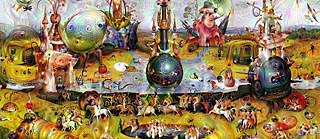Possibilities of Utopian Storytelling
Island in the Unmapped Sky
“ATTENTION!” a bird bellows above me, “and it [is] as though an oboe ha[s] [...] become articulate.” “Here and Now!" the bird continues to roar. Obviously, I am stranded! Above me I see pool-blue skies, a tiny jewel of a cloud, two cut palm fronds, and for a few seconds as well, “two exquisite children looking down at [me].” [1]
Their gender is obviously unimportant, and they need not be half-naked. In fact, it doesn’t have to be children at all. I think the two even seem quite old.
Dr. Mc, says one of them now. And that is Dr. Su. And then (“small talk” refers here only to a niche TV show genre), they sit down next to me in the sand and tell me about their island — how happy “Here and Now!” everyone is, how well their health care system works, how reliable the free public transportation is, and so on. “Don’t you sometimes despair?” I interrupt. They shake their heads. “Because we know that things don’t have to be as bad as in fact they’ve always been. Because they are better on this absurd little island” [2].
With that, they have already described the function of their island well: “to set in motion the process of critical comparison [between reality and utopia]” [3], “in order to sharpen the sense for the possible within the real.” [4] In other words: Utopia is a counter-image to current forms of coexistence. To be a counter-, it must, however, also contain an image-ination and is thereby always related to its concrete original context. As such a situated counter-image it is firstly unattainable and secondly static. These are its essential features, the second conditioning the first. “It is nowhere. It is pure model; goal,” explains Dr. Su, who is an expert on dream islands. “Utopia is uninhabitable,” “static perfection is an essential element of [that] non-inhabitability” [5] “Here and Now,” cries the bird.
As a counter-image to “things in fact,” “this absurd little island” is of course part of a tradition, continues Dr. Su. In the 16th century, Pala would have been called “Utopia” or “Nova Atlantis” and would have been an island state — a necessarily isolated, totalitarian-ruled society, in which subjective interests and the common good become one in such a way that one can truly speak of happiness. Stasis through control, desirelessness through state-regulated wish fulfillment.
The Palas of the 18th century barely differed from their predecessors in terms of the forms of coexistence depicted. However, they were no longer located in space but rather in time, which among other things, is due to the secularization (of Judeo-Christian eschatology), which was accompanied by a new image of man (Menschenbild) as well as a new understanding of history as a process of progress. Utopias (and critiques of utopia) provided much-needed answers to the question of the goal of this progress.
With the change, however, a contradiction became increasingly apparent ... Dr. Su stands up and reaches out a hand to me. “Rousseau’s assessment — that subject and society cannot be brought to consensus in their interests if the subject is taken seriously in its own way — leads to the discovery of the fundamental dialectic of utopia” [6] and thereby to a new self-reflexivity of the genre, they say, as we walk past a herd of giraffes the size of full-grown miniature pinschers. The literary consequence of this is the dominance of dystopias. Here, in the anti-utopias such as H.G. Wells’s The Time Machine or E.M. Forster’s The Machine Stops, utopia turns to horror in which the degeneration of the ruled is shown as the consequence of radical thinking about progress.
How do you get out of here now, I ask? By opening up the utopian narrative and also telling its conditions along with it, answers Dr. Su. Just like Le Guin in The Dispossessed, says Dr. Mc. Or Yevgeny Zamyatin in We. For them, the connection between utopia and anti-utopia, the thinking through of the danger of a reversal, was the condition for utopian narration. One could also say: Contingency became the utopian program.
And why do such contingent utopias barely exist today, I ask. Dr. Su puffs out their cheeks. Read Frederic Jameson, read Mark Fisher, they say, my throat is dry. In a history- and future-less state of stasis, as Fisher describes the present, it is simply difficult to qualitatively imagine something completely different. However, caricatures of old utopias continue to reappear inside contemporary science fiction, and a reversal of the causality between perfection and standstill is apparent. Virtual islands on which one can disappear [7], island communities without misunderstandings [8], are static and therefore perfect — not the other way around. Passivity to the point of self-dissolution — that is the dream. “It’s easier to imagine the end of the world,” [9] says Dr. Mc, than a coexistence in which our greatest desire is not to dissolve. Dr. Su caresses me on the head. No wonder it seems impossible to conceive a utopian counter-image in a system that stabilizes itself through the endogenization of any critique of the system. Utopia as a form of critique is no exception here, they say. With a snap of the fingers, a collage of articles, books, talk shows, and Harald Welzer interviews appears on a holographic display through which a flock of cockatoos flies. All kinds of people want to know that we lack utopias. But the thinking here is about the path, not the destination. The question is: What’s missing? Most add silently: to keep going. The others shout: to change the system.
Whereby an answer to the second question can all too easily become the answer to the first. The system has made the contingency its program, so to speak. Does that make sense? In any case, Huxley seems to have already sensed this appropriation of utopia. In this way, the end of Island — the invasion of the exploiters can be read not merely as a critique of imperialism: Those powers also conquer and destroy the notion of perfect stasis with the ancient Pala. To depict this looming appropriation, Huxley draws on narrative patterns of the past and checks their validity in the present. Once again, he takes up the principle of spatial utopia, only to subsequently reject it once more, newly justified. His utopian narrative becomes a “narrative about the possibilities of utopian narrative” [10] from which one might conclude: Utopia must change.
And perhaps it must not stop changing at all anymore. In a dynamic system, utopia must also have to dynamize where possible in order to escape. Who said that now, asks Dr. Su. I did, I say. If we can’t imagine a perfect stasis from our now-time (Jetztzeit), then we should rather think first of (non-)places, where this is (was) possible. To dig up the “unfinished now-time of the dead” that spreads beneath “the now of the living” [11] might also mean creating a foundation for utopian thinking. “The [...] porcupine goes backward to speculate safely on the future.” [12] I would like to retreat like Huxley to the “now-time of the dead” in order to make images and counter-images of the now-time of the living from here. That does not mean dehistoricization. On the contrary, it is a matter of treating past utopias as products of their time, of arming them against the detemporalizing grip of nostalgic fashions by keeping them open, by constantly retelling them and telling them differently, in collaboration. The method I am proposing resembles academic work as a practice of capturing and building on in that regard as well: It relies on collaboration and thereby offers security — the security that the stories will go on and on — the security of not having to “make it alone,” [13] of having someone complement my counter-images with others — the security that someone is sighted, where I am blind. Critique is a threat here only in the sense that it puts my imperfect notions of perfect stasis into question but also saves them by allowing them to enter into ever new imperfect perceptions of perfect non-place.
Collaborative fanfiction is what I call this method, and I didn’t invent that. Donna Haraway and her colleagues practice something similar in Staying with the Trouble. In the artist bubble, “hauntology and the practice of storytelling in terms of linking” are trending topics. [14] And in subreddits such as r/Futurology, on Orion’s Arm, and in the Star Trek forums and fanzines, forms of collaborative storytelling of fictional, potentially infinite, and partly utopian stories have been experimented with for decades, I say, somewhat out of breath. They exist! The utopias. One just has to look in the right places and build on it ... In the meantime, we have arrived at the edge of a canyon, where a few people are inflating a kind of bouncy castle. As I sit down on the ground, I see a figure in a loose t-shirt descend into the canyon. As she sees us, she stops and waves. She’s wearing the same t-shirt as me, only hers is greener than mine. Who is that, I ask. My companions laugh. You didn’t really believe you were here first, did you?
What the fuck?
This article was commissioned by and created in collaboration with Das Wetter – Magazin für Text und Musik.
“Heaven, heaven is a place
A place where nothing
Nothing ever happens”Talking Heads
With that, they have already described the function of their island well: “to set in motion the process of critical comparison [between reality and utopia]” [3], “in order to sharpen the sense for the possible within the real.” [4] In other words: Utopia is a counter-image to current forms of coexistence. To be a counter-, it must, however, also contain an image-ination and is thereby always related to its concrete original context. As such a situated counter-image it is firstly unattainable and secondly static. These are its essential features, the second conditioning the first. “It is nowhere. It is pure model; goal,” explains Dr. Su, who is an expert on dream islands. “Utopia is uninhabitable,” “static perfection is an essential element of [that] non-inhabitability” [5] “Here and Now,” cries the bird.
As a counter-image to “things in fact,” “this absurd little island” is of course part of a tradition, continues Dr. Su. In the 16th century, Pala would have been called “Utopia” or “Nova Atlantis” and would have been an island state — a necessarily isolated, totalitarian-ruled society, in which subjective interests and the common good become one in such a way that one can truly speak of happiness. Stasis through control, desirelessness through state-regulated wish fulfillment.
The Palas of the 18th century barely differed from their predecessors in terms of the forms of coexistence depicted. However, they were no longer located in space but rather in time, which among other things, is due to the secularization (of Judeo-Christian eschatology), which was accompanied by a new image of man (Menschenbild) as well as a new understanding of history as a process of progress. Utopias (and critiques of utopia) provided much-needed answers to the question of the goal of this progress.
With the change, however, a contradiction became increasingly apparent ... Dr. Su stands up and reaches out a hand to me. “Rousseau’s assessment — that subject and society cannot be brought to consensus in their interests if the subject is taken seriously in its own way — leads to the discovery of the fundamental dialectic of utopia” [6] and thereby to a new self-reflexivity of the genre, they say, as we walk past a herd of giraffes the size of full-grown miniature pinschers. The literary consequence of this is the dominance of dystopias. Here, in the anti-utopias such as H.G. Wells’s The Time Machine or E.M. Forster’s The Machine Stops, utopia turns to horror in which the degeneration of the ruled is shown as the consequence of radical thinking about progress.
How do you get out of here now, I ask? By opening up the utopian narrative and also telling its conditions along with it, answers Dr. Su. Just like Le Guin in The Dispossessed, says Dr. Mc. Or Yevgeny Zamyatin in We. For them, the connection between utopia and anti-utopia, the thinking through of the danger of a reversal, was the condition for utopian narration. One could also say: Contingency became the utopian program.
And why do such contingent utopias barely exist today, I ask. Dr. Su puffs out their cheeks. Read Frederic Jameson, read Mark Fisher, they say, my throat is dry. In a history- and future-less state of stasis, as Fisher describes the present, it is simply difficult to qualitatively imagine something completely different. However, caricatures of old utopias continue to reappear inside contemporary science fiction, and a reversal of the causality between perfection and standstill is apparent. Virtual islands on which one can disappear [7], island communities without misunderstandings [8], are static and therefore perfect — not the other way around. Passivity to the point of self-dissolution — that is the dream. “It’s easier to imagine the end of the world,” [9] says Dr. Mc, than a coexistence in which our greatest desire is not to dissolve. Dr. Su caresses me on the head. No wonder it seems impossible to conceive a utopian counter-image in a system that stabilizes itself through the endogenization of any critique of the system. Utopia as a form of critique is no exception here, they say. With a snap of the fingers, a collage of articles, books, talk shows, and Harald Welzer interviews appears on a holographic display through which a flock of cockatoos flies. All kinds of people want to know that we lack utopias. But the thinking here is about the path, not the destination. The question is: What’s missing? Most add silently: to keep going. The others shout: to change the system.
Whereby an answer to the second question can all too easily become the answer to the first. The system has made the contingency its program, so to speak. Does that make sense? In any case, Huxley seems to have already sensed this appropriation of utopia. In this way, the end of Island — the invasion of the exploiters can be read not merely as a critique of imperialism: Those powers also conquer and destroy the notion of perfect stasis with the ancient Pala. To depict this looming appropriation, Huxley draws on narrative patterns of the past and checks their validity in the present. Once again, he takes up the principle of spatial utopia, only to subsequently reject it once more, newly justified. His utopian narrative becomes a “narrative about the possibilities of utopian narrative” [10] from which one might conclude: Utopia must change.
And perhaps it must not stop changing at all anymore. In a dynamic system, utopia must also have to dynamize where possible in order to escape. Who said that now, asks Dr. Su. I did, I say. If we can’t imagine a perfect stasis from our now-time (Jetztzeit), then we should rather think first of (non-)places, where this is (was) possible. To dig up the “unfinished now-time of the dead” that spreads beneath “the now of the living” [11] might also mean creating a foundation for utopian thinking. “The [...] porcupine goes backward to speculate safely on the future.” [12] I would like to retreat like Huxley to the “now-time of the dead” in order to make images and counter-images of the now-time of the living from here. That does not mean dehistoricization. On the contrary, it is a matter of treating past utopias as products of their time, of arming them against the detemporalizing grip of nostalgic fashions by keeping them open, by constantly retelling them and telling them differently, in collaboration. The method I am proposing resembles academic work as a practice of capturing and building on in that regard as well: It relies on collaboration and thereby offers security — the security that the stories will go on and on — the security of not having to “make it alone,” [13] of having someone complement my counter-images with others — the security that someone is sighted, where I am blind. Critique is a threat here only in the sense that it puts my imperfect notions of perfect stasis into question but also saves them by allowing them to enter into ever new imperfect perceptions of perfect non-place.
Collaborative fanfiction is what I call this method, and I didn’t invent that. Donna Haraway and her colleagues practice something similar in Staying with the Trouble. In the artist bubble, “hauntology and the practice of storytelling in terms of linking” are trending topics. [14] And in subreddits such as r/Futurology, on Orion’s Arm, and in the Star Trek forums and fanzines, forms of collaborative storytelling of fictional, potentially infinite, and partly utopian stories have been experimented with for decades, I say, somewhat out of breath. They exist! The utopias. One just has to look in the right places and build on it ... In the meantime, we have arrived at the edge of a canyon, where a few people are inflating a kind of bouncy castle. As I sit down on the ground, I see a figure in a loose t-shirt descend into the canyon. As she sees us, she stops and waves. She’s wearing the same t-shirt as me, only hers is greener than mine. Who is that, I ask. My companions laugh. You didn’t really believe you were here first, did you?
What the fuck?
This article was commissioned by and created in collaboration with Das Wetter – Magazin für Text und Musik.







